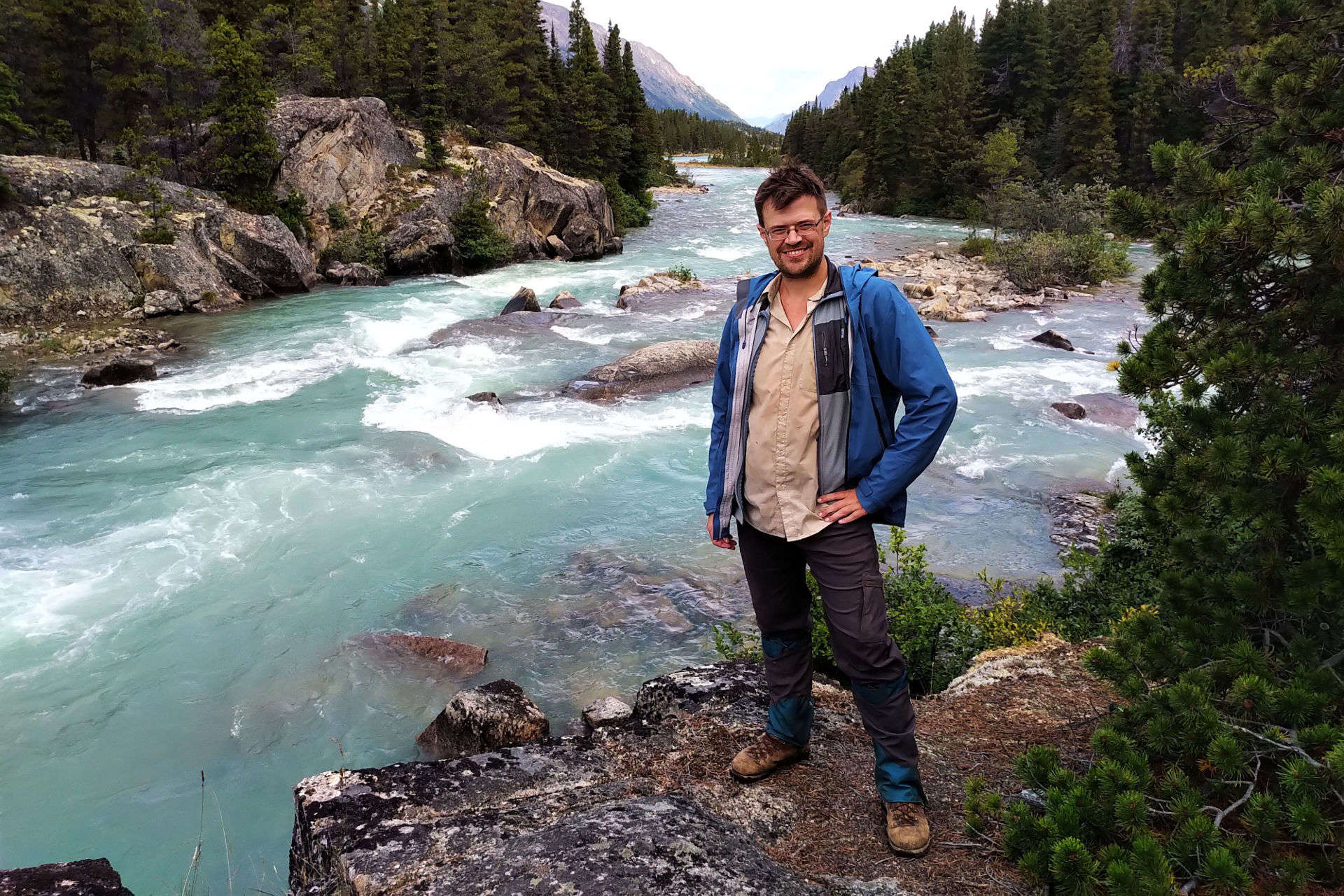On the night of September 29, Doug Inglis, Jenny Gusse, and their seven-year-old dog were killed in their tent by a grizzly bear on Banff’s remote Red Deer River.
There is no sign that the victims made any mistake. They were highly experienced in the outdoors. In that region of Banff National Park there are no bear hangs or lockers but bearproof food containers are mandatory and the park says they hung their food properly: if the park could tell that, it implies the bear didn’t get it. They carried bear spray, and emptied a can of it. They had a satellite messenger and the presence of mind to send an SOS, but the weather made it impossible for rescue by helicopter and even if it hadn’t, it would have taken a miracle to save them. While responding Parks Canada killed an older, underweight, aggressive female grizzly, and while the area of the attack is still closed to travel in case she wasn’t the bear responsible, the profile fits: it was late in the season, a cold spring has made for a bad berry crop, and bears jumping a camp is virtually always a predatory attack from an animal who is desperate for food before winter.
Small comfort, probably, to their families. It was the worst of all possible luck. Twitter comments were happy to write fan fiction about how it was probably their fault in some unspecified way but it wasn’t. It had probably been a couple days since the hikers had seen another human. Their ebooks were out. They were in their tent reading, waiting out crummy weather before bed. Any backpacker can see the scene in his head without having met either victim or knowing a thing about them besides where they were and what they loved to do.
The author of this post knows something of that trail second-hand; he’s never been there but is planning to hike it in 2024 and has been researching it a lot. Note that verb, is rather than was. Those who go outside must show humility before nature, and if one is to experience the backcountry at all, one must accept the risk of bear, river, lightning, injury, heart attack, or falling tree. The trees in the Canadian Rockies kill more than the bears do. This was the first fatal bear attack in a Canadian Rockies national park since September 1992, when a grizzly killed Trevor Percy-Lancaster in Jasper’s Tonquin Valley1.
Repeating it for emphasis: it doesn’t look like there was anything Doug Inglis and Jenny Gusse could have done differently. Late September is peak bear attack season, as the hungry ones resort to anything to survive, but few have total control over when we can go backpacking and, on that trail, fast-moving unbridged river crossings make a late hike safer2. The Red Deer valley is narrow in that area and if you want to avoid wildlife corridors you don’t go at all. They had a dog, and dogs have been known to attract bears, but that wouldn’t account for a sustained predatory attack that killed two people despite firing an entire can of bear spray3. A common comment is “they should have carried a gun.” Firearms are illegal in national parks except for government officers but never mind that: they were in their tent, not trying to pick off a charging bear in the open. Under the circumstances they would have been better off armed than not but shooting a grizzly dead in a life-or-death melee on a rainy night is, for the average backpacker, not in the realm of the practical4. Remember the hiker in Jasper who shot a black bear with a 20-gauge shotgun earlier that summer: a warning shot failed to scare the bear away, and after being hit the bear ran off although the hiker had his gun in hand and a clear shot across a creek. Shooting bears takes some doing, that’s why where grizzly hunting is legal the guides make the big bucks.
Humility. Nature is bigger than us. That’s why we go. Stuart Howe, a Canadian YouTube backpacker, hiked this same trail earlier in the summer and was bluff-charged by an unusually aggressive grizzly a day’s hiking from the attack site. It’s thought-provoking to watch it now, but Stuart got nothing worse than a scare and maybe motivation to hike a bit further that day. You might have heard of Timothy Treadwell, the “Grizzly Man” of Werner Herzog fame who went into the depths of Alaska bear habitat to take videos and get up close to them. Unsafe though his bear practices were said to be, he spent twelve summers out there unharmed until he and his girlfriend were killed in quite a similar fashion: late in the season, while peaceably in camp not surprising anyone or getting between anyone and her cubs, Treadwell and Amie Huguenard were killed in a predatory attack by an underweight old bear who would have struggled to survive the winter.
Humility is not the same as submissiveness. Some people have said it was a shame the bear that probably killed Inglis and Gusse was shot, and setting aside the fact that the bear was killed because it was aggressive towards armed park wardens (they should have let themselves be attacked?), it shouldn’t be controversial that humans ought to be on the top of the food chain. Grizzlies in Alberta aren’t even endangered anymore. Grizzly bears are great, beautiful creatures, but humans are greater and more beautiful still. The loss of the occasional mean old bear is, as the rising population numbers prove, no danger to biodiversity.
Because nothing was done wrong, there is nothing to correct. Whenever a news outlet reports on a story like this they reach out to the friendly local bear expert who says the same things: that whatever the nature of this attack, most bear attacks are a human’s fault, and you should do all these things so it doesn’t happen to you. It’s not that it’s bad advice. Store your food well, make lots of noise, keep your dog under control, and know what to do when you have an encounter so well that, when it actually happens, you won’t forget. Proper human behaviour in bear country does work, in the sense that it’s been demonstrated to reduce the number of encounters and make those that do happen less severe. So it’s hard to argue with them, especially since a bear expert almost by definition loves bears and doesn’t want to see them become a problem. It’s not merely good self-preservation, it’s good natural stewardship, and all humans are called to be stewards of nature5.
The quotes of the bear experts, however, somewhat missed the point this time. We should all seek the wisdom to know what we can change, and the strength to change it, but also the strength and wisdom to accept what we cannot. Even if you do it all right, the bear gets a say too. Bears can defeat bearproof food storage, they can get desperate the same as any other creature, they are smart, huge, perceptive, dangerous, surprisingly hard to see, and sometimes unavoidable. Unless we stay away from bear country entirely or kill all the bears—neither of which is acceptable—these things will happen.
It’s not an easy mindset in today’s society. There is an attitude that all of nature, from the smallest virus to the world itself, is under our command, that we can defeat death with science, or, contrarily-but-not-really, that the Earth is a loving Gaia-mother who will care for us if we care for it. Neither is true. Backpackers bring their safety gear, they clip on their satellite messengers, they check the safety on their bear spray (or their gun), they get weather forecasts from space while walking maintained trails carrying the knowledge of those who have been there before in infinite quantity, and that makes nature safer, but that’s not the same as having subdued it. Nor, in the last analysis, does the backpacker want a subdued, tame experience, because there’s a reason one hikes down the Red Deer River rather than the Edmonton river valley.
To lose this simple truth behind technology, procedure, and other human inventions is to miss something very important. Backpacking is not an extreme sport. It is not mountaineering or ice-climbing. However, the very things that give it an element of risk are why we do it. Be humbly aware of this, and go not afraid.
- There have been fatal bear attacks outside the parks in the Canadian Rockies since then, but most have been joggers, mountain bikers, hunters, trappers, and other use cases not seen in the parks’ deep backcountry.
- Rivers, also, kill more backpackers than bears do.
- For example, in April a black bear killed a dog in Jasper National Park. Despite one of the hikers involved not only firing bear spray at the bear but hitting him in the face with the empty can, the bear stuck to the dog. The bear was later killed by park staff.
- American readers should remember that, in Canada, the right to armed self-defense does not exist. Pistols are essentially illegal and much else is unobtainable so your bear defense weapon is something like a bolt-action .308 Winchester with a 22″ barrel weighing seven pounds without ammunition. As a piece of one-use-in-a-generation safety gear it would be the heaviest, most expensive, and most difficult-to-deal-with item in any backpacker’s kit. Even when you need it, fishing a rifle out and shooting accurately during an attack in a tent, in the dark, while it’s raining and your partner is being killed is not a scenario for a novice.
- Genesis 2:5–20.




Thanks for your thoughtful and informed piece. Much appreciated.